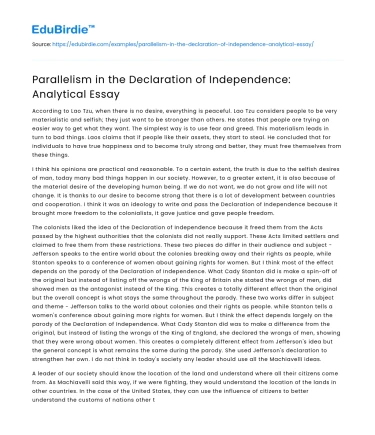Introduction
The Declaration of Independence, a seminal text in American history, is not merely a proclamation of autonomy from British rule but also a masterful piece of rhetoric. Thomas Jefferson, the principal author, employed a variety of rhetorical devices to persuasively articulate the colonies' grievances and justify their break from England. Among these devices, parallelism stands out as a particularly powerful tool. Parallelism, the repetition of grammatical structures, serves to emphasize key ideas, enhance the text's rhythm, and facilitate memorability. This essay explores how parallel structures in the Declaration of Independence underscore its fundamental themes of equality, rights, and governance. By examining specific sections of the document, this analysis highlights how Jefferson's use of parallelism contributes to the overall persuasiveness and enduring impact of the Declaration.
The Role of Parallelism in Emphasizing Equality and Rights
Parallelism is prominently used in the Declaration of Independence to underscore the philosophical foundations of equality and human rights. One of the most famous examples occurs in the preamble: "We hold these truths to be self-evident, that all men are created equal, that they are endowed by their Creator with certain unalienable Rights, that among these are Life, Liberty and the pursuit of Happiness." Here, the repetition of the word "that" introduces a series of clauses that are grammatically parallel, reinforcing the interconnectedness and equal importance of each assertion. This structural repetition not only underscores the universality of these principles but also makes the statement more memorable and impactful, aiding its transmission and adoption as a core tenet of American ideology.
Save your time!
We can take care of your essay
- Proper editing and formatting
- Free revision, title page, and bibliography
- Flexible prices and money-back guarantee
The effectiveness of this parallel structure can be seen in its influence on subsequent documents and speeches. For instance, Martin Luther King Jr.'s "I Have a Dream" speech echoes the Declaration's parallel construction to emphasize civil rights, demonstrating the enduring legacy of Jefferson's rhetorical choices. Critics might argue that parallelism in the Declaration oversimplifies complex ideas; however, its simplicity is a strategic choice, aiming to reach a broad audience and galvanize support. By presenting profound truths in an accessible manner, Jefferson ensures that the principles of equality and rights are not only understood but also cherished and defended.
Parallelism and the Articulation of Grievances
In addition to asserting fundamental rights, the Declaration employs parallelism extensively in its list of grievances against King George III. This section uses a repetitive structure to catalog the perceived injustices, beginning many clauses with "He has" or "For," as in "He has refused his Assent to Laws, the most wholesome and necessary for the public good." This repetition serves several purposes. Firstly, it creates a rhythmic cadence that underscores the systematic nature of the tyrannies described, suggesting that these are not isolated incidents but part of a larger pattern of abuse.
Moreover, the parallel structure intensifies the emotional impact of the grievances, evoking a sense of moral outrage and justifying the colonies' decision to sever ties with Britain. Each repeated phrase builds upon the previous one, culminating in a crescendo of accusations that portray the King as a tyrant. This technique ensures that the reader is not only informed but also emotionally engaged, thus enhancing the persuasive power of the document. While some may contend that the use of parallelism in this section could overwhelm the reader with its sheer volume, it is precisely this saturation that reinforces the necessity of independence. By bombarding the audience with a relentless litany of complaints, Jefferson leaves little room for doubt about the legitimacy of the colonists' cause.
Parallelism in the Conclusion and Its Call to Action
In the conclusion of the Declaration, parallelism is again employed to rally support and inspire action. The concluding statements assert the colonies' status as "Free and Independent States" and emphasize their right to "do all other Acts and Things which Independent States may of right do." The parallelism here is not only a linguistic flourish but a strategic call to unity and resolve. By repeating the structure, Jefferson reinforces the legitimacy and inevitability of the colonies' new status, encouraging both domestic and international audiences to recognize and support their sovereignty.
The repeated emphasis on independence through parallel structures also serves to forge a collective identity among the colonies, transforming their shared grievances into a unified national cause. Critics might suggest that reliance on parallelism risks reducing complex political realities into overly simplified statements. However, in the context of a revolutionary document, such simplicity is a rhetorical strength, distilling the central message into a form that is both powerful and accessible. By harnessing the clarity and force of parallelism, the Declaration of Independence not only articulates a vision of a new nation but also galvanizes the resolve needed to bring that vision to fruition.
Conclusion
The strategic use of parallelism in the Declaration of Independence is a testament to Thomas Jefferson's rhetorical acumen. By employing this device, Jefferson effectively emphasizes the document's core themes, making a compelling case for independence that resonates across the centuries. The repetition of grammatical structures enhances the text's memorability, persuasiveness, and emotional impact, ensuring its enduring influence on American ideals and identity. While some may argue that parallelism oversimplifies complex issues, its clarity and forcefulness are precisely what make the Declaration such a powerful instrument of change. Through a careful analysis of its use in emphasizing equality, articulating grievances, and inspiring action, this essay demonstrates how parallelism not only strengthens the Declaration's arguments but also cements its place as a foundational manifesto of human rights and self-governance.






 Stuck on your essay?
Stuck on your essay?

